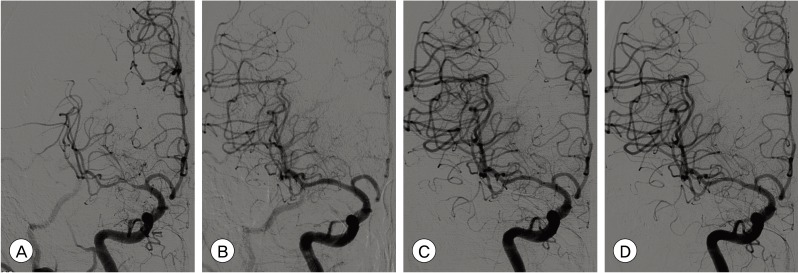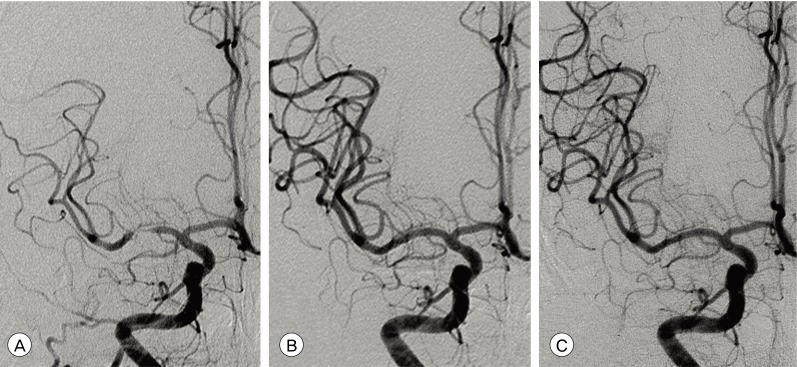J Cerebrovasc Endovasc Neurosurg.
2013 Jun;15(2):85-95. 10.7461/jcen.2013.15.2.85.
Comparison of Drug-eluting Coronary Stents, Bare Coronary Stents and Self-expanding Stents in Angioplasty of Middle Cerebral Artery Stenoses
- Affiliations
-
- 1Department of Radiology, S-Jungang Hospital, Jeju, Republic of Korea.
- 2Department of Neurosurgery, Donghae Dongin Hospital, Donghae, Republic of Korea.
- 3Department of Neurology, Gangneung Asan Hospital, College of Medicine, University of Ulsan, Gangneung, Republic of Korea.
- 4Department of Neurosurgery, Gangneung Asan Hospital, College of Medicine, University of Ulsan, Gangneung, Republic of Korea. y77y85@hanmail.net
- KMID: 1980434
- DOI: http://doi.org/10.7461/jcen.2013.15.2.85
Abstract
OBJECTIVE
The purpose of this study is to investigate the results of treatment using stent-angioplasty for symptomatic middle cerebral arterial (MCA) stenosis and comparison of in-stent restenosis between drug-eluting stents (DES), bare metal coronary stents (BMS) and self-expanding stents (SES).
MATERIALS AND METHODS
From Jan. 2007 to June. 2012, 34 patients (mean age +/- standard deviation: 62.9 +/- 13.6 years) with MCA stenosis were treated. Inclusion criteria were acute infarction or transient ischemic attacks (TIAs) and angiographically proven symptom related severe stenosis. Stents used for treatment were DES (n = 8), BMS (n = 13) and SES (n = 13). National Institutes of Health Stroke Scale (NIHSS) at admission was 2.5 +/- 3.1 and mean stenosis rate was 79.0 +/- 8.2%. Assessment of clinical and angiographic results was performed retrospectively.
RESULTS
Among 34 patients, periprocedural complications occurred in four cases (11.8%), however, only two cases (6.0%) were symptomatic. All patients were followed clinically (mean follow-up period; 40.7 +/- 17.7 months) and 31 were followed angiographically (91.2%. 13.4 +/- 8.5 months). There was no occurrence of repeat stroke in all patients; however, mild TIAs related to restenosis occurred in three of 34 patients (8.8%). The mean NIHSS after stent-angioplasty was 1.7 +/- 2.9 and 0.8 +/- 1.1 at discharge. The modified Rankin score (mRS) at discharge was 0.5 +/- 0.9 and 0.3 +/- 0.8 at the last clinical follow-up. In-stent restenosis over 50% occurred in five of 31 angiographically followed cases (16.1%), however, all of these events occurred only in patients who were treated with BMS or SES. Restenosis rate was 0.0% in the DES group and 20.8% in the other group (p = 0.562); it did not differ between BMS and SES (2/11 18.2%, 3/13 23.1%, p = 1.000).
CONCLUSION
Stent-angioplasty appears to be effective for symptomatic MCA stenosis. As for restenosis, in our study, DES was presumed to be more effective than BMS and SES; meanwhile, the results did not differ between the BMS and SES groups.
Keyword
MeSH Terms
Figure
Reference
-
1. Abou-Chebl A, Bashir Q, Yadav JS. Drug-eluting stents for the treatment of intracranial atherosclerosis: initial experience and midterm angiographic follow-up. Stroke. 2005; 12. 36(12):e165–e168. PMID: 16282539.
Article2. Albuquerque FC, Levy EI, Turk AS, Niemann DB, Aagaard-Kienitz B, Pride GL Jr, et al. Angiographic patterns of Wingspan in-stent restenosis. Neurosurgery. 2008; 7. 63(1):23–27. PMID: 18728565.
Article3. Al Hasan M, Murugan R. Stenting versus aggressive medical therapy for intracranial arterial stenosis: more harm than good. Crit Care. 2012; 5. 16(3):310. PMID: 22574950.
Article4. Arenillas JF, Molina CA, Montaner J, Abilleira S, González-Sánchez MA, Alvarez-Sabín J. Progression and clinical recurrence of symptomatic middle cerebral artery stenosis: a long-term follow-up transcranial Doppler ultrasound study. Stroke. 2001; 12. 32(12):2898–2904. PMID: 11739993.5. Bose A, Hartmann M, Henkes H, Liu HM, Teng MM, Szikora I, et al. A novel, self-expanding, nitinol stent in medically refractory intracranial atherosclerotic stenoses: the Wingspan study. Stroke. 2007; 5. 38(5):1531–1537. PMID: 17395864.6. Boulos AS, Agner C, Deshaies EM. Preliminary evidence supporting the safety of drug-eluting stents in neurovascular disease. Neurol Res. 2005; 27(Suppl 1):S95–S102. PMID: 16197833.
Article7. Chimowitz MI, Lynn MJ, Derdeyn CP, Turan TN, Fiorella D, Lane BF, et al. Stenting versus aggressive medical therapy for intracranial arterial stenosis. N Engl J Med. 2011; 9. 365(11):993–1003. PMID: 21899409.8. Derdeyn CP, Fiorella D, Lynn MJ, Barnwell SL, Zaidat OO, Meyers PM, et al. Impact of operator and site experience on outcomes after angioplasty and stenting in the SAMMPRIS trial. J Neurointerv Surg. 2012; 9. 12.
Article9. De Rochemont Rdu M, Turowski B, Buchkremer M, Sitzer M, Zanella FE, Berkefeld J. Recurrent symptomatic high-grade intracranial stenoses: safety and efficacy of undersized stents-initial experience. Radiology. 2004; 4. 231(1):45–49. PMID: 15068940.10. De Silva DA, Woon FP, Lee MP, Chen CP, Chang HM, Wong MC. South Asian patients with ischemic stroke: intracranial large arteries are the predominant site of disease. Stroke. 2007; 9. 38(9):2592–2594. PMID: 17656660.11. Fiorella D, Levy EI, Turk AS, Albuquerque FC, Niemann DB, Aagaard-Kienitz B, et al. US multicenter experience with the wingspan stent system for the treatment of intracranial atheromatous disease: periprocedural results. Stroke. 2007; 3. 38(3):881–887. PMID: 17290030.
Article12. Fiorella D, Levy EI, Turk AS, Albuquerque FC, Pride GL Jr, Woo HH, et al. Target lesion revascularization after wingspan: assessment of safety and durability. Stroke. 2009; 1. 40(1):106–110. PMID: 18927447.13. Gröschel K, Schnaudigel S, Pilgram SM, Wasser K, Kastrup A. A systematic review on outcome after stenting for intracranial atherosclerosis. Stroke. 2009; 5. 40(5):e340–e347. PMID: 19182081.
Article14. Henkes H, Miloslavski E, Lowens S, Reinartz J, Liebig T, Kühne D. Treatment of intracranial atherosclerotic stenoses with balloon dilatation and self-expanding stent deployment (Wingspan). Neuroradiology. 2005; 3. 47(3):222–228. PMID: 15912418.
Article15. Jiang WJ, Du B, Leung TW, Xu XT, Jin M, Dong KH. Symptomatic Intracranial Stenosis: cerebrovascular complications from elective stent placement. Radiology. 2007; 4. 243(1):188–197. PMID: 17392253.
Article16. Kim JS, You SH, Kim SR, Kim SD, Kim YW, Park IK, et al. Usefulness of drug-eluting stents in angioplasty and stenting of the vertebral artery origin: comparison with bare stents. Korean J Cerebrovasc Surg. 2005; 7(2):135–142.17. Lee J, Kwon S, Lee JH, Suh DC, Kim JS. Percutaneous transluminal angioplasty for symptomatic middle cerebral artery stenosis: long-term follow-up. Cerebrovasc Dis. 2003; 15(1-2):90–97. PMID: 12499717.
Article18. Lee JH, Yun JK, Kim DW, Kang SD. Clinical and angiographic outcomes of Wingspan stent placement for treatment of symptomatic intracranial stenosis: single center experience with 19 cases. J Cerebrovasc Endovasc Neurosurg. 2012; 9. 14(3):157–163. PMID: 23210041.
Article19. Levy EI, Turk AS, Albuquerque FC, Niemann DB, Aagard-Kienitz B, Pride L, et al. Wingspan in-stent restenosis and thrombosis: incidence, clinical presentation, and management. Neurosurgery. 2007; 9. 61(3):644–650. discussion 650-1. PMID: 17881980.20. Marks MP, Marcellus ML, Do HM, Schraedley-Desmond PK, Steinberg GK, Tong DC, et al. Intracranial angioplasty without stenting for symptomatic atherosclerotic stenosis: long-term follow-up. AJNR Am J Neuroradiol. 2005; 3. 26(3):525–530. PMID: 15760860.21. Marks MP, Marcellus M, Norbash AM, Steinberg GK, Tong D, Albers GW. Outcome of angioplasty for atherosclerotic intracranial stenosis. Stroke. 1999; 5. 30(5):1065–1069. PMID: 10229745.
Article22. Marks MP, Wojak JC, Al-Ali F, Jayaraman M, Marcellus ML, Connors JJ, et al. Angioplasty for symptomatic intracranial stenosis: clinical outcome. Stroke. 2006; 4. 37(4):1016–1020. PMID: 16497979.23. Morice MC, Serruys PW, Sousa JE, Fajadet J, Ban Hayashi E, Perin M, et al. A randomized comparison of a sirolimus-eluting stent with a standard stent for coronary revascularization. N Engl J Med. 2002; 6. 346(23):1773–1780. PMID: 12050336.
Article24. Park S, Lee DG, Chung WJ, Lee DH, Suh DC. Long-term outcomes of drug-eluting stents in symptomatic intracranial stenosis. Neurointervention. 2013; 2. 8(1):9–14. PMID: 23515851.
Article25. Scheller B, Hehrlein C, Bocksch W, Rutsch W, Haghi D, Dietz U, et al. Two year follow-up after treatment of coronary in-stent restenosis with a paclitaxel-coated balloon catheter. Clin Res Cardiol. 2008; 10. 97(10):773–781. PMID: 18536865.
Article26. Shin YS, Kim BM, Suh SH, Jeon P, Kim DJ, Kim DI, et al. Wingspan stenting for intracranial atherosclerotic stenosis: clinical outcomes and risk factors for in-stent restenosis. Neurosurgery. 2013; 4. 72(4):596–604. discussion 604. PMID: 23277374.27. Steinfort B, Ng PP, Faulder K, Harrington T, Grinnell V, Sorby W, et al. Midterm outcomes of paclitaxel-eluting stents for the treatment of intracranial posterior circulation stenoses. J Neurosurg. 2007; 2. 106(2):222–225. PMID: 17410703.
Article28. Stettler C, Wandel S, Allemann S, Kastrati A, Morice MC, Schömig A, et al. Outcomes associated with drug-eluting and bare-metal stents: a collaborative network meta-analysis. Lancet. 2007; 9. 370(9591):937–948. PMID: 17869634.
Article29. Stone GW, Ellis SG, Cox DA, Hermiller J, OShaughnessy C, Mann JT, et al. A polymer-based, paclitaxel-eluting stent in patients with coronary artery disease. N Engl J Med. 2004; 1. 350(3):221–231. PMID: 14724301.
Article30. Tarlov N, Jahan R, Saver JL, Sayre JW, Ali LK, Kim D, et al. Treatment of high risk symptomatic intracranial atherosclerosis with balloon mounted coronary stents and Wingspan stents: single center experience over a 10 year period. J Neurointerv Surg. 2012; 1. 4(1):34–39. PMID: 21990460.
Article31. The SSYLVIA Study Investigators. Stenting of symptomatic atherosclerotic lesions in the vertebral or intracranial arteries (SSYLVIA): study results. Stroke. 2004; 6. 35(6):1388–1392. PMID: 15105508.32. Turk AS, Levy EI, Albuquerque FC, Pride GL Jr, Woo H, Welch BG, et al. Influence of patient age and stenosis location on wingspan in-stent restenosis. AJNR Am J Neuroradiol. 2008; 1. 29(1):23–27. PMID: 17989366.
Article33. Vajda Z, Aguilar M, Göhringer T, Horváth-Rizea D, Bäzner H, Henkes H. Treatment of intracranial athero sclerotic disease with a balloon-expandable paclitaxel eluting stent: procedural safety, efficacy and mid-term patency. Clin Neuroradiol. 2012; 9. 22(3):227–233. PMID: 22252289.34. Vajda Z, Güthe T, Perez MA, Heuschmid A, Schmid E, Bäzner H, et al. Neurovascular in-stent stenoses: treatment with conventional and drug-eluting balloons. AJNR Am J Neuroradiol. 2011; Nov-Dec. 32(10):1942–1947. PMID: 21885715.
Article35. Vajda Z, Güthe T, Perez MA, Kurre W, Schmid E, Bäzner H, et al. Prevention of intracranial in-stent restenoses: predilatation with a drug eluting balloon, followed by the deployment of a self-expanding stent. Cardiovasc Intervent Radiol. 2013; 4. 36(2):346–352. PMID: 22869043.
Article36. Yoon W, Seo JJ, Cho KH, Kim MK, Kim BC, Park MS, et al. Symptomatic middle cerebral artery stenosis treated with intracranial angioplasty: experience in 32 patients. Radiology. 2005; 11. 237(2):620–626. PMID: 16192322.
Article
- Full Text Links
- Actions
-
Cited
- CITED
-
- Close
- Share
- Similar articles
-
- Is There a Benefit of Drug-Eluting Stents Rather than Bare Metal Stents in Large Coronary Artery Lesions?
- Usefulness of Drug-Eluting Stents in Angioplasty and Stenting of the Vertebral Artery Origin : Comparison with Bare Stents: Clinical Research
- Current status of drug-eluting stents
- Risk of Stent Stenosis after Implanting a First-Generation Drug-Eluting Stent and Drug Balloon Angioplasty
- Novel Coronary Stent Platforms




